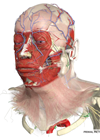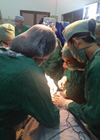Features
The gender affirmation surgery MDT
The authors provide a comprehensive and thought-provoking discussion of the multidisciplinary nature of caring for someone undergoing gender reassignment surgery. In the last 50 years in the UK an estimated 130,000 people have changed their gender assigned at birth (assigned...
Life after medicine
Our Editor, Andrew Burd, renowned burns surgeon, takes us on a fascinating journey from his early days as a medical student travelling in the USA through his search for scarless healing in the 1980s and finally to his current work...
Facial veins – diagnosis and treatment options
Facial veins can be treated with a wide range of aesthetic and surgical procedures. Victoria Smith and Professor Mark Whiteley, both experts in the area, provide a comprehensive overview of diagnosis and the different treatment options available. Patients with unwanted...
The creation of PlayDoh® models as an educational tool for teaching anatomy of the eyelid
A full understanding of the anatomy of the eyelid is essential for oculoplastic surgeons; the authors guide us through an innovative way to improve the teaching of this important subject. An understanding of the anatomy of the eyelid is essential...
A suggested management pathway for rhinophyma and benign superficial skin lesions that includes the use of plasma
Rhinophyma is an aesthetic embarrassment to many people. It is the result of sebaceous gland hyperplasia within the skin over the alar cartilages of the nose. It has a familial tendency and in addition to being unsightly it can commonly...
A practical guide to the most commonly used dressings in wound care
The author explores and reviews the most popular classes of dressings used for acute, chronic and problem wounds, their properties and indications based on direct observation and research studies. With an ever-increasing armamentarium of wound care tools, different brands and...
A picture is worth a thousand words… communicating with your patients more effectively
Communicating information effectively with patients is essential yet often challenging. Plastic Surgeon Gavin Miller takes us through his approach to using online resources to make the process as effective as possible. Getting ideas across to other people isn’t always easy,...
‘Rhinofiller’: non-surgical correction of the nose
Dr Agolli from Italy advocates the use of filler to quickly and easily achieve a non-surgical rhinoplasty without downtime for the patient. Cultural basis It is believed that Dante Alighieri was not a handsome man, probably because of his appearance,...
British Foundation for International Surgery and Training
Two of the UK’s most innovative Plastic Surgeons, Barbara Jemec and Wee Lam, give a fascinating account of the work of BFIRST overseas and, perhaps most importantly, explain how you can get involved. The British Foundation for International Surgery and...
Closed rhinoplasty Serdev techniques
Why is rhinoplasty so important? Facial beauty and harmony are dependent on correct aesthetic angles, volumes and proportions. The complex face is properly divided into three equal parts: forehead, nose, and lower part (where the upper lip forms a ratio...
Real-world use of telemedicine – a picture is worth a thousand words
Recent advances in mobile phone camera technology and app software design have allowed photos of patients and their wounds to be sent from any smartphone to a secure NHS database, which can then be accessed by the relevant clinician with...
Filler complications: is there a way to prevent vascular compromise with 3D-anatomy?
The use of facial filler injections has increased dramatically over the last 10 years and so has the incidence of complications. The main and most serious adverse event is vascular compromise. The most feared consequences are devastating: blindness, skin necrosis...















